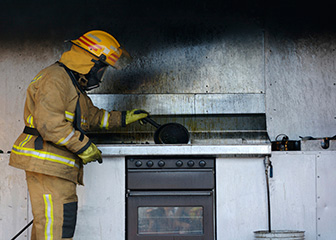Summary
Please enable javascript to play this video.
| Quick Facts: Fire Inspectors | |
|---|---|
|
$71,420 per year
$34.34 per hour |
|
| See How to Become One | |
| See How to Become One | |
| Moderate-term on-the-job training | |
| 17,400 | |
| 5% (Faster than average) | |
| 900 | |
What Fire Inspectors Do
Fire inspectors detect fire hazards, recommend prevention measures, ensure compliance with state and local fire regulations, and investigate causes of fires.
Work Environment
Fire inspectors work in office settings and onsite, including outdoors. Most work full time, and some work more than 40 hours per week. Their schedules may include evenings, weekends, and holidays because they must be ready to respond when fires occur.
How to Become a Fire Inspector
To enter the occupation, fire inspectors typically need at least a high school diploma or equivalent and work experience as a firefighter or in a related occupation. Once hired, they typically receive on-the-job-training in inspection and investigation. They also may need certification.
Pay
The median annual wage for fire inspectors and investigators was $74,160 in May 2023.
The median annual wage for forest fire inspectors and prevention specialists was $54,080 in May 2023.
Job Outlook
Overall employment of fire inspectors is projected to grow 5 percent from 2022 to 2032, faster than the average for all occupations.
About 1,600 openings for fire inspectors are projected each year, on average, over the decade. Many of those openings are expected to result from the need to replace workers who transfer to different occupations or exit the labor force, such as to retire.
State & Area Data
Explore resources for employment and wages by state and area for fire inspectors.
Similar Occupations
Compare the job duties, education, job growth, and pay of fire inspectors with similar occupations.
More Information, Including Links to O*NET
Learn more about fire inspectors by visiting additional resources, including O*NET, a source on key characteristics of workers and occupations.
 United States Department of Labor
United States Department of Labor







